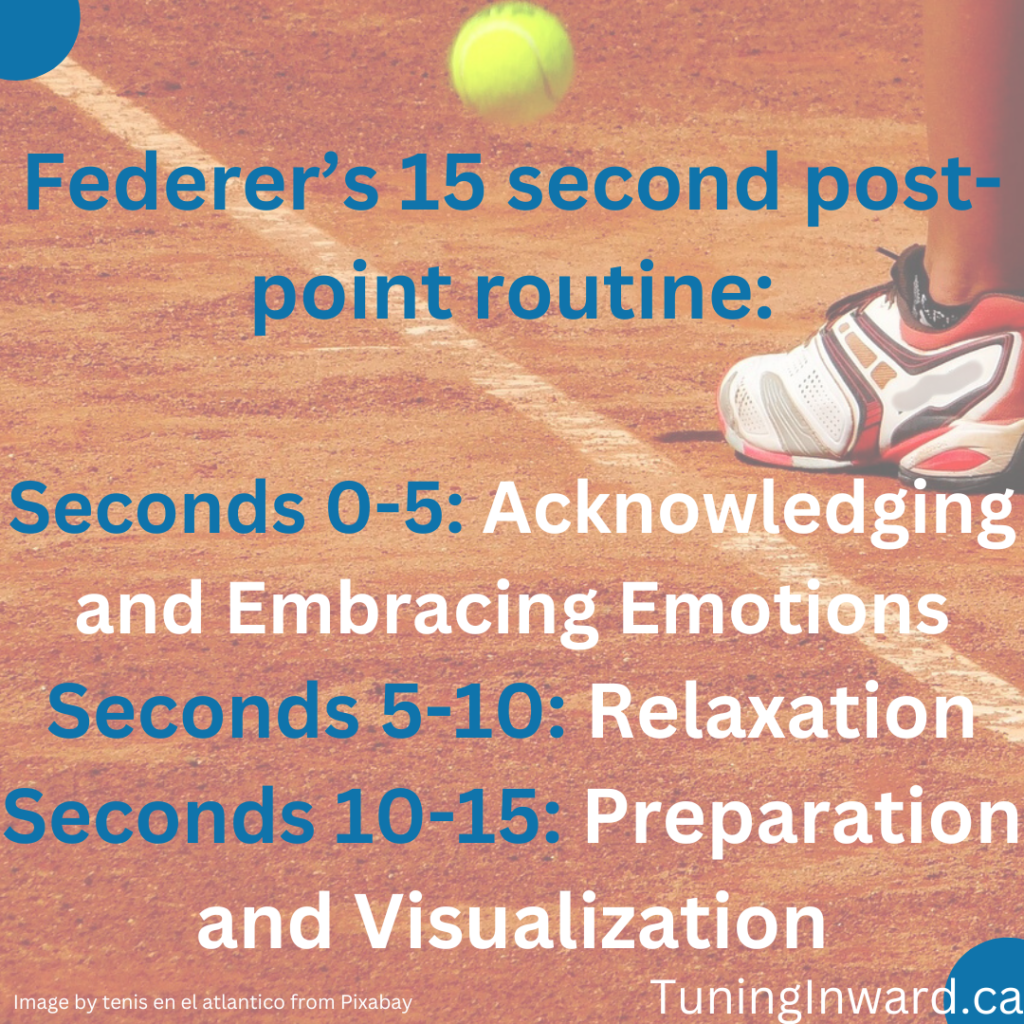Tennis legend Roger Federer’s recent viral (and excellent!) commencement address at Dartmouth College shared much wisdom.
One of the most shared extracts related to the theme of when you lose. He said:
The truth is, whatever game you play in life, sometimes you’re going to lose…The best in the world are not the best because they win every point…It’s because they know they’ll lose…again and again…and have learned how to deal with it.
We often hear about how important it is to move on or make the most of a failure; unfortunately, however, how to do it effectively is more elusive.
Prior to his farewell match at the Laver Cup in 2022, Federer shared his 15-second routine between points. His meticulously crafted routine is not just about physical readiness but, perhaps more importantly, about the power of mental agility and resilience.

I think his process is quite effective beyond sports, including in professional (and personal) domains, especially when we take advantage of being off the tennis court, as it permits us to take more than a few seconds for each stage.
Seconds 0-5: Acknowledge and Embrace Emotions
Federer begins his routine by dedicating the first five seconds to the emotions he is experiencing: recognizing, acknowledging and embracing them. He says: “Point to point, my feelings can change a lot, so it’s important I’m aware of them so that I can either hold onto, or let go of, that feeling for the next point.”
For professionals, this step can be pivotal after a heated negotiation or a critical feedback session. Taking a few moments to identify and acknowledge your emotions—be it satisfaction, frustration, elation or disappointment—can prevent these feelings from clouding your judgment. It’s about giving yourself the permission to feel without letting those emotions dictate your next move.
Seconds 6-10: Relaxation
The next five seconds in Federer’s routine are dedicated to relaxation. Regardless of the outcome of the previous point, he focuses on calming his mind and body, primarily through breathing exercises. This phase is crucial as it helps transition from an emotional response to a state of calm readiness.
In a professional setting, particularly after or before intense or high-stakes discussions, taking a moment to relax can reset your mental state. Simple breathing exercises (such as box breathing) or a brief mindfulness practice (such as taking 90 seconds to focus on one of your physical senses with deep attention) can help dissipate tension and bring you back to a balanced state. This relaxation phase ensures that you approach the next task with a clear and focused mind.
Federer recognizes this can be challenging in the moment, so he emphasizes keeping it simple: “To be able to relax when the occasion is big and the pressure is high is a difficult thing to do. So, I keep it simple and focus on my breathing and relaxing the muscles in my body.”
Seconds 11-15: Preparation and Visualization
It is only after the first two phases that Federer moves into preparation for the next point: “Only when I’m ready will I go into this phase.” This last phase is about planning the strategy for the next point – and he does this through visualizing his actions and the desired outcome. He says:
“This is when I plan my plan of action for how I want to start the point and how I would like it to finish. This is through visualization. I will plan where I’m serving and my next shot. From there I will visualize how I see the point finishing in my head. This gives me confidence and a feeling that I’m in control. Now, I’m ready to start the point.
This mental rehearsal builds his confidence and gives him a sense of control.
For professionals, this is the phase where strategic thinking comes into play. After moving ourselves out of a stress response, our body and mind are primed to think critically: allowing us to be both tactical and strategic. Plan and visualize the desired outcome of your next action, whether it’s a follow-up meeting, a critical decision, or an important presentation. This mental preparation can enhance your confidence and readiness, allowing you to tackle the task with a clear and positive mindset.
Summary and Plan of Action
Federer’s 15-second routine is a powerful tool that professionals can adapt to improve their effectiveness and resilience.
Here’s a simple framework modified to allow for slightly more time at each phase to incorporate this routine into your professional life:
- Be aware of and acknowledge your emotions (2 minutes): After a challenging interaction or receiving feedback, pause to observe your emotions. This awareness can prevent emotional responses from affecting your next actions.
- Relax and Reset (3 minutes): Engage in a brief relaxation exercise, such as deep breathing or mindfulness. This helps to re-focus your mind and reduces stress, preparing you for the next task.
- Prepare and Visualize (5+ minutes): The step of planning your next actions can now start. (Most professionals try to move to this first.) Now that your mind and body are ready for critical thinking, planning can be conducted more effectively. In addition to mapping out the actions and steps, consider visualizing a successful outcome. This mental preparation boosts confidence and ensures a focused approach.
Inspired by this routine, professionals can aim to navigate their careers (and lives outside of work) with the same precision and mental fortitude that Federer demonstrates on the court.
Try it out and let us know what you think!
We hope you embrace this practice, fostering a more mindful, resilient, and strategic approach to your professional challenges.